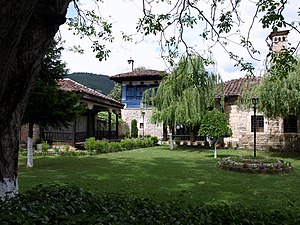Arabati Baba Teḱe
| Arabati Baba Tekke | |
|---|---|
 |
|
| Basic information | |
| Location | Tetovo, Macedonia |
| Geographic coordinates | 42°00′15″N 20°57′27″E / 42.004109°N 20.957567°ECoordinates: 42°00′15″N 20°57′27″E / 42.004109°N 20.957567°E |
| Affiliation | Bektashi |
| Country | Republic of Macedonia |
| Architectural description | |
| Architect(s) | Harabati Baba |
| Architectural type | Tekke |
| Architectural style | Ottoman architecture |
| Completed | 1538 |
| Materials | Stones & Kalkan |
The Arabati Baba Tekḱe is a tekḱe located in Tetovo, Republic of Macedonia. The tekke was originally built in 1538 around the türbe of Sersem Ali Baba, an Ottoman dervish. In 1799, a waqf provided by Recep Paşa established the current grounds of the tekke. The finest surviving Bektashi monastery in Europe, the sprawling complex features flowered lawns, prayer rooms, dining halls, lodgings and a great marble fountain inside a wooden pavilion.
Ali Baba was the brother-in-law of Sultan Suleiman the Magnificent, and had been a high-ranking Baba in the important Dimetoka Teḱe (now in Didymoteicho) when his sister (who was one of the sultan’s wives) fell into disfavor with her husband. As a result, Ali Baba was banished to Kalkandelen (present-day Tetovo) at the outer fringes of the Ottoman Empire where he started his own Teḱe.
Another version of the story goes that Ali Baba was an official of the Ottoman Empire who gave up his position in order to live the simple life of a Bektashi monk. Sultan Suleiman the Magnificent, angered by the departure of one of his favorite officials, yelled after Ali as he departed Istanbul, ‘‘If you will be a fool, then go.’’ Sersem, the old Turkish for ‘fool’, became Ali Baba’s nickname thereafter.
Whichever is the true story (the Turks favour the first one), Sersem travelled the vast empire of Turkey until he came upon the River Pena in the tranquil mountains of Tetovo. There he settled until his death in 1538, quietly practicing the way of the Bektashi order. After his death, his only pupil to survive him, Arabati Baba, founded a monastery in Tetovo to commemorate Sersem’s life.
The present-day buildings were built at the end of the 18th century by Rexhep Pasha, also a dervish, whose tomb lies next to Sersem’s in the teḱe mausoleum. Not all the buildings are still standing today; in the courtyard was originally built to house the sick daughter of Abdurrahman Pasha. The reception inn is still in disrepair, although the library is being refurbished. One of the buildings has been turned into a Sunni mosque, but the inns around the Bektashi graveyard have been preserved for the Baba.
...
Wikipedia
